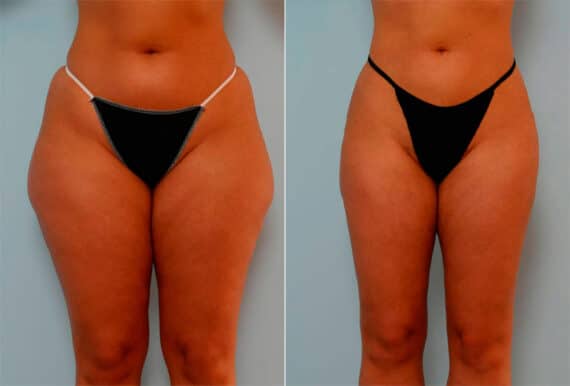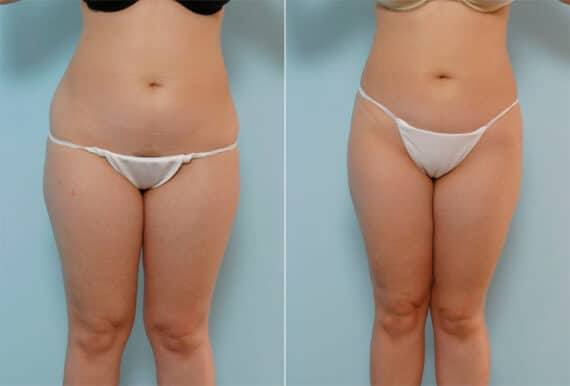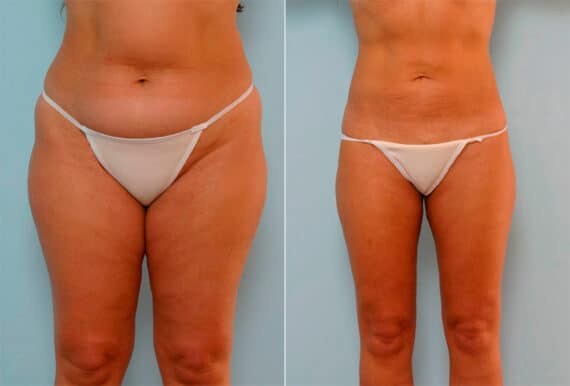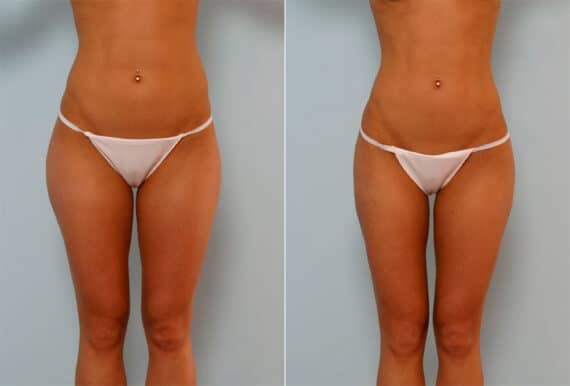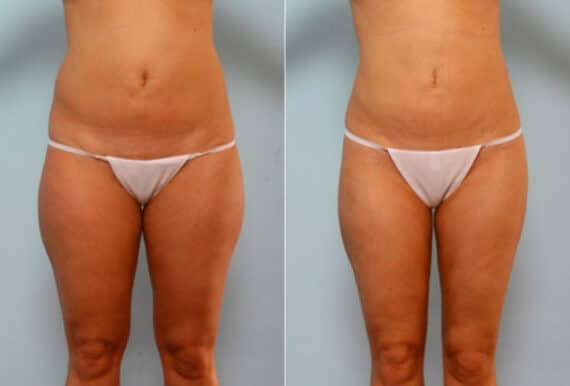30+ Years of Experience
3k+ Real Patient Reviews
10,000+ Surgeries Performed
Texas Super Doctor
Liposuction in Houston
Liposuction in the hand of an artist like Dr. Vitenas can change a body’s shape permanently. With liposuction by Dr. Vitenas, you can finally say goodbye to stubborn fat cells that are resistant to diet and exercise. As body contouring expert he has the experience to to sculpt your body into a slimmer, more toned, and youthful physique.

Discover why patients from across the U.S. and around the world choose Dr. Vitenas as their premier Houston surgeon.

Achieve Your Dream Body with Expert Liposuction in Houston
Liposuction is one of the most popular cosmetic procedures for removing unwanted pockets of fat and sculpting beautiful body contours. This minimally invasive body contouring treatment provides dramatic improvements that are unattainable with diet and exercise alone.
During your liposuction consultation in Houston, Dr. Paul Vitenas will evaluate your areas of concern and develop a customized treatment plan targeting the precise fat deposits that you want to eliminate. With his surgical skills and advanced liposuction techniques, liposuction can effectively and safely remove unwanted fat cells.
- Permanently removes stubborn excess skin unresponsive to diet and exercise
- Reduces fat deposits in targeted areas to sculpt an attractive, slimmer figure
- Reshapes your physique and enhances your natural contours
- Provides dramatic improvements to your self-image and self-confidence
Effective Fat Removal with Liposuction
Liposuction surgery is a body contouring procedure that directly removes stubborn fat cells and sculpts specific areas of your body. During this surgical procedure, your Houston plastic surgeon will make small incisions near the targeted fatty deposits and insert a thin tube called a cannula. The cannula is connected to a vacuum device that suctions out the fat.
Common treatment areas for liposuction surgery include:
- Abdomen and waist
- Hips, thighs, knees
- Back and bra rolls
- Arms
- Neck and chin
- Breasts
At Vitenas Cosmetic Surgery in Houston, various liposuction techniques are offered to cater to individual needs and preferences. Among these options are:
- Tumescent method: This method involves injecting a specialized solution into the targeted area before the fat removal process. The solution helps minimize bleeding and discomfort, leading to a smoother and more comfortable procedure.
- Power-assisted liposuction: In this method, a powered cannula (a thin tube) is utilized, which vibrates or rotates to aid in the removal of fat. This mechanical assistance allows for more effective fat extraction, particularly in fibrous or densely packed areas.
Patients can discuss their aesthetic goals and concerns with Dr. Vitenas to determine the most suitable approach for their desired body contouring results.
Ideal Liposuction Candidates
Ideal candidates for liposuction in Houston are individuals who are close to their ideal body weight and live a healthy lifestyle but have localized fat deposits resistant to diet and exercise. Good candidates have good skin elasticity and are seeking small refinements to curves or reduction of fat bulges.
During your consultation, your Houston plastic surgeon will determine if you are a good candidate based on the following:
- Your overall health and medical history
- The location and amount of fat you want to be removed
- Your skin elasticity and tone
- Your realistic expectations for results

Your Free Liposuction Consultation
Dr. Vitenas' Expert Liposuction Technique in Houston
During your liposuction procedure, Dr. Vitenas will utilize his surgical skills and artistic eye to sculpt your body into a more attractive, contoured shape. He customizes each treatment plan using advanced techniques to safely and effectively remove unwanted fat.
Dr. Vitenas commonly uses tumescent liposuction for precise results with minimal discomfort. This technique involves injecting a solution before fat removal to swell the tissue and constrict blood vessels. The solution contains saline, lidocaine for numbing, and epinephrine to reduce bleeding.
After injecting the tumescent solution, Dr. Vitenas will insert a small suction tube called a cannula through tiny incisions near the treatment area. He will skillfully guide the cannula through the fat deposits, suctioning out the unwanted fat cells. The solution enables large amounts of fat to be removed while minimizing bleeding, bruising, and swelling.
At our state-of-the-art Houston Surgery Center, Dr. Vitenas can perform this outpatient procedure under general anesthesia for your comfort and safety. He has over 30 years of liposuction experience in Houston, providing beautiful, natural-looking improvements in body contour.
Transforming Specific Body Areas with Liposuction
Liposuction can effectively reshape and contour many areas of your body that have stubborn localized fat. Dr. Vitenas will tailor your treatment plan to meet your cosmetic goals for a harmonious result.
Slimming the Midsection with Abdominal Liposuction
One of the most popular uses of liposuction is sculpting a flatter, more toned abdominal area. Even with diet and exercise, some individuals have persistent belly fat or love handles. Abdominal liposuction can provide a slimmer waistline and smoother contours.
Trimming the Arms with Brachioplasty
The upper arms are a troublesome area, especially for women. Arm liposuction removes excess fat deposits to provide more attractive, proportional arms with better definition. Your arms will take on a firmer, more youthful appearance.
Contouring the Thighs and Hips
Localized fat in the outer thighs that creates a “saddlebag” look can be effectively reduced with liposuction. Refining the hips and thighs provides more balanced lower body curves. Clothing fits better, and the results boost confidence.
Rejuvenating the Neck and Chin Area
The neck and chin are common areas of fat accumulation that can make you appear older. Liposuction techniques can eliminate the “double chin” appearance for a crisper, more youthful jawline and neck contour.
Enhancing the Buttocks
In some cases, liposuction can be used to carefully reshape the buttocks, but this must be done with precision to avoid contour irregularities. Removing the excess outer thigh or flank fat can also highlight the buttocks’ curves.Create a Leaner Back
Back liposuction can target various regions, including the upper back, lower back, and the area around the bra line.

Resting and Recovering After Liposuction
Comfortable Recovery After Liposuction
While the recovery process varies, you can expect:
- Discomfort, bruising, and swelling for about 1 week; most patients return to work in 1 week
- Wear a compression garment for several weeks to control swelling
- Limit strenuous activity for 4-6 weeks
On average, patients see their final results in 3 months. Dr. Vitenas will provide detailed post-procedure instructions so you know what to expect during your recovery. He will also prescribe medication to keep you as comfortable as possible.
Proper rest and sufficient hydration are essential during your recovery to support healing and maintain your beautiful results. With Dr. Vitenas’ expert care, you will return to your normal activities quickly.



Why Choose Dr. Vitenas for Liposuction
- Board-certified plastic surgeon
- Over 30 years of performing advanced body sculpting procedures
- Utilizes the safest, most effective liposuction techniques
- Customizes every detail of your treatment plan
- Operates at Houston Surgery Center, his accredited facility
- Known for outstanding patient care from consultation through recovery
Houston Liposuction FAQ
What is liposuction?
Is liposuction painful?
Who is a good candidate for liposuction?
How is the liposuction procedure performed?
Vitenas Cosmetic Surgery uses several liposuction techniques:
- Tumescent liposuction injects fluid to numb the area and constricts blood vessels before fat removal.
- Power-assisted liposuction uses a powered cannula to remove fat more easily.
Dr. Vitenas will recommend the best technique for your treatment goals.
Where do the liposuction incisions get placed?
How long is the liposuction procedure?
What areas can be treated with liposuction?
The abdomen, flanks, back, thighs, knees, hips, arms, neck, and chin are common treatment areas for liposuction. Your surgeon will customize the exact treatment areas to meet your cosmetic goals.
How long is the recovery from liposuction?
How can I maintain my liposuction results?
What are the risks and complications of liposuction?
Liposuction is very safe when performed by an experienced, board-certified plastic surgeon. Possible side effects include swelling, bruising, numbness, and discomfort. Rare risks include infection, scarring, asymmetry, and blood clots. Be aware of these risks since they could be signs of a botched liposuction.
What can go wrong with liposuction?
This is considered to be a safe procedure, but there is a small chance of side effects or complications that can lead to a bad liposuction. These can include bleeding, infection, scarring, seroma, blood clots, and fat embolism.
Can I exercise after liposuction?
Dr. Vitenas recommends waiting around 6 weeks before resuming regular exercise activities. This can vary from patient to patient.
What is the price of liposuction?
The starting cost for liposuction is around $4,500, but this can vary depending on the method used and the particular area targeted for treatment. This initial cost includes the surgical fees, expenses for the operating room, fees for the anesthesiologist, and all necessary post-operative care. The precise cost for your liposuction will be established during your consultation.



